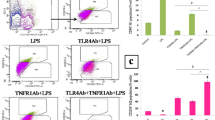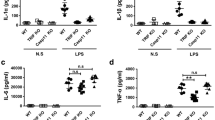Abstract
This study aimed to investigate the mechanism of type I interferon (IFN) in aggravating sepsis in bacterial infection, focusing on the roles of Caspase-11 (Casp11) and Gasdermin D (Gsdmd) in this process. Type I interferons, including IFNα and IFNβ, were used to treat peritoneal macrophage harvested from wild-type or IFNα/βR1 knockout (KO) mice, of which the levels of Casp11 and Gsdmd were monitored using real-time polymerase chain reaction (RT-PCR) and Western blot, the exposure to phosphatidylserine was monitored by flow cytometry, and tissue factor (TF) activation was assessed by RT-PCR and TF chromogenic assay. Endotoxemia in wild-type mice led to upregulation of Casp11 and Gsdmd in myeloid cells, which in contrast was attenuated in IFNα/βR1 KO mice. IFNα or IFNβ treatment led to dose-dependent upregulation of Casp11 and Gsdmd in peritoneal macrophages harvested from wild-type mice, but induced negligible changes in IFNα/βR1 KO mice. Type I IFN promoted phosphatidylserine exposure in peritoneal macrophage from wild-type mice but not IFNα/βR1 KO mice. Type I IFN induced insignificant changes of TF expression levels in both wild-type mice and IFNα/βR1 KO mice, but the TF activity was markedly increased in wild-type mice after type I IFN treatment. Our data suggested that the upregulation of Casp11 and Gsdmd in myeloid cells and macrophages induced by endotoxemia was reliant on the expression of IFNα/βR1. IFNα or IFNβ treatment efficiently upregulated Casp11 and Gsdmd, phosphatidylserine exposure, and TF activity of macrophages. Therefore, type I IFN could aggravate sepsis through upregulating Casp11 and Gsdmd.





Similar content being viewed by others
References
Badr G (2013) Blocking type I interferon signaling rescues lymphocytes from oxidative stress, exhaustion, and apoptosis in a streptozotocin-induced mouse model of type I diabetes. Oxidative medicine and cellular longevity 2013
Byrne L, Van Haren F (2017) Fluid resuscitation in human sepsis: time to rewrite history? Ann Intensive Care 7:4. https://doi.org/10.1186/s13613-016-0231-8
Chen K, Liu J, Cao X (2017) Regulation of type I interferon signaling in immunity and inflammation: a comprehensive review. J Autoimmun 83:1–11. https://doi.org/10.1016/j.jaut.2017.03.008
Dejager L, Vandevyver S, Ballegeer M, Van Wonterghem E, An LL, Riggs J, Kolbeck R, Libert C (2014) Pharmacological inhibition of type I interferon signaling protects mice against lethal sepsis. J Infect Dis 209:960–970. https://doi.org/10.1093/infdis/jit600
Deng M, Tang Y, Li W, Wang X, Zhang R, Zhang X, Zhao X, Liu J, Tang C, Liu Z, Huang Y, Peng H, Xiao L, Tang D, Scott MJ, Wang Q, Liu J, Xiao X, Watkins S, Li J, Yang H, Wang H, Chen F, Tracey KJ, Billiar TR, Lu B (2018) The endotoxin delivery protein HMGB1 mediates caspase-11-dependent lethality in sepsis. Immunity 49(740–753):e747. https://doi.org/10.1016/j.immuni.2018.08.016
Eskici ZM, Acikgoz S, Piskin N, Mungan G, Can M, Guven B, Kokturk F (2012) High mobility group B1 levels in sepsis and disseminated intravascular coagulation. Acta Biochim Pol 59:561–566
Iba T, Ito T, Maruyama I, Jilma B, Brenner T, Muller MC, Juffermans NP, Thachil J (2016) Potential diagnostic markers for disseminated intravascular coagulation of sepsis. Blood Rev 30:149–155. https://doi.org/10.1016/j.blre.2015.10.002
Kang R, Zeng L, Zhu S, Xie Y, Liu J, Wen Q, Cao L, Xie M, Ran Q, Kroemer G, Wang H, Billiar TR, Jiang J, Tang D (2018) Lipid peroxidation drives gasdermin D-mediated pyroptosis in lethal polymicrobial sepsis. Cell Host Microbe 24:97–108.e104. https://doi.org/10.1016/j.chom.2018.05.009
Makara MA, Hoang KV, Ganesan LP, Crouser ED, Gunn JS, Turner J, Schlesinger LS, Mohler PJ, Rajaram MV (2016) Cardiac electrical and structural changes during bacterial infection: an instructive model to study cardiac dysfunction in sepsis. J Am Heart Assoc 5:e003820. https://doi.org/10.1161/JAHA.116.003820
McDonald B, Davis RP, Kim SJ, Tse M, Esmon CT, Kolaczkowska E, Jenne CN (2017) Platelets and neutrophil extracellular traps collaborate to promote intravascular coagulation during sepsis in mice. Blood 129:1357–1367. https://doi.org/10.1182/blood-2016-09-741298
Micek ST, Welch EC, Khan J, Pervez M, Doherty JA, Reichley RM, Hoppe-Bauer J, Dunne WM, Kollef MH (2011) Resistance to empiric antimicrobial treatment predicts outcome in severe sepsis associated with Gram-negative bacteremia. J Hosp Med 6:405–410. https://doi.org/10.1002/jhm.899
Minasyan H (2017) Sepsis and septic shock: pathogenesis and treatment perspectives. J Crit Care 40:229–242. https://doi.org/10.1016/j.jcrc.2017.04.015
Moore JX, Donnelly JP, Griffin R, Howard G, Safford MM, Wang HE (2016) Defining sepsis mortality clusters in the United States. Crit Care Med 44:1380–1387. https://doi.org/10.1097/CCM.0000000000001665
Painz R, Walter I, Kolbe T, Rigler D, Vogl C, Steinborn R, Rülicke T, Helmreich M, Karaghiosoff M, Müller M (2008) Organ-specific and differential requirement of TYK2 and IFNAR1 for LPS-induced iNOS expression in vivo. Immunobiology 212:863–875
Seymour CW, Gesten F, Prescott HC, Friedrich ME, Iwashyna TJ, Phillips GS, Lemeshow S, Osborn T, Terry KM, Levy MM (2017) Time to treatment and mortality during mandated emergency care for sepsis. N Engl J Med 376:2235–2244. https://doi.org/10.1056/NEJMoa1703058
Silva BNG, Andriolo RB, Atallah AN, Salomao R (2010) De-escalation of antimicrobial treatment for adults with sepsis, severe sepsis or septic shock. Cochrane Database Syst Rev
Snell LM, McGaha TL, Brooks DG (2017) Type I interferon in chronic virus infection and cancer. Trends Immunol 38:542–557. https://doi.org/10.1016/j.it.2017.05.005
Vatsyayan R, Kothari H, Pendurthi UR, Rao LV (2013) 4-Hydroxy-2-nonenal enhances tissue factor activity in human monocytic cells via p38 mitogen-activated protein kinase activation-dependent phosphatidylserine exposure. Arterioscler Thromb Vasc Biol 33:1601–1611. https://doi.org/10.1161/ATVBAHA.113.300972
Wang E, Liu Y, Qiu X, Tang Y, Wang H, Xiao X, Chen F, Lu B (2019) Bacteria-released outer membrane vesicles promote disseminated intravascular coagulation. Thromb Res 178:26–33. https://doi.org/10.1016/j.thromres.2019.03.019
Weiss SL, Fitzgerald JC, Balamuth F, Alpern ER, Lavelle J, Chilutti M, Grundmeier R, Nadkarni VM, Thomas NJ (2014) Delayed antimicrobial therapy increases mortality and organ dysfunction duration in pediatric sepsis. Crit Care Med 42:2409–2417. https://doi.org/10.1097/CCM.0000000000000509
Yang H, Hreggvidsdottir HS, Palmblad K, Wang H, Ochani M, Li J, Lu B, Chavan S, Rosas-Ballina M, Al-Abed Y, Akira S, Bierhaus A, Erlandsson-Harris H, Andersson U, Tracey KJ (2010) A critical cysteine is required for HMGB1 binding to Toll-like receptor 4 and activation of macrophage cytokine release. P Natl Acad Sci USA 107:11942–11947. https://doi.org/10.1073/pnas.1003893107
Yang X, Cheng X, Tang Y, Qiu X, Wang Y, Kang H, Wu J, Wang Z, Liu Y, Chen F (2019) Bacterial endotoxin activates the coagulation cascade through gasdermin D-dependent phosphatidylserine exposure. Immunity 51:983-996. e986
Yang X, Cheng X, Tang Y, Qiu X, Wang Z, Fu G, Wu J, Kang H, Wang J, Wang H, Chen F, Xiao X, Billiar TR, Lu B (2020) The role of type 1 interferons in coagulation induced by gram-negative bacteria. Blood 135:1087–1100. https://doi.org/10.1182/blood.2019002282
Funding
The study was supported by Zhang Jingyu, Nature Science Foundations of Hebei Province, China (H2018206423).
Author information
Authors and Affiliations
Corresponding author
Ethics declarations
Conflict of interest
The authors declare no competing interests.
Additional information
Publisher’s note
Springer Nature remains neutral with regard to jurisdictional claims in published maps and institutional affiliations.
Key Points
1. Type I IFN promoted phosphatidylserine exposure in peritoneal macrophages from wild-type mice.
2. IFNα or IFNβ treatment efficiently upregulates Casp11 and Gsdmd.
3. Type I IFN induces insignificant changes of TF expression levels.
Rights and permissions
About this article
Cite this article
Wang, Y., Zhang, X., Guo, Y. et al. Type 1 interferon aggravates lipopolysaccharide-induced sepsis through upregulating Caspase-11 and Gasdermin D. J Physiol Biochem 77, 85–92 (2021). https://doi.org/10.1007/s13105-021-00785-1
Received:
Accepted:
Published:
Issue Date:
DOI: https://doi.org/10.1007/s13105-021-00785-1




